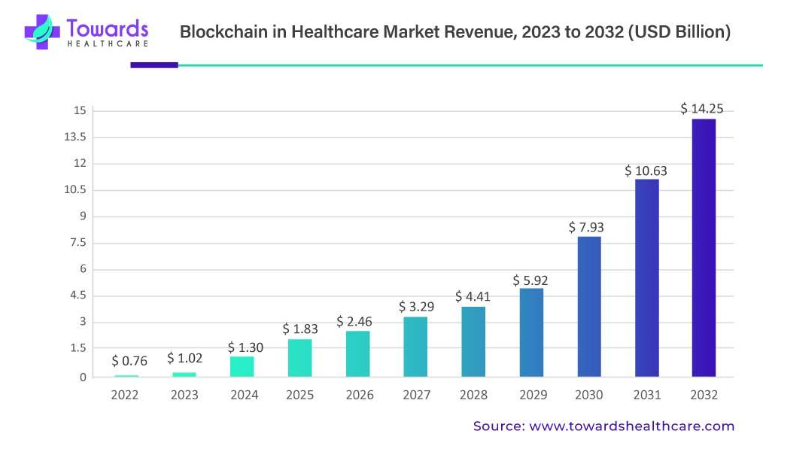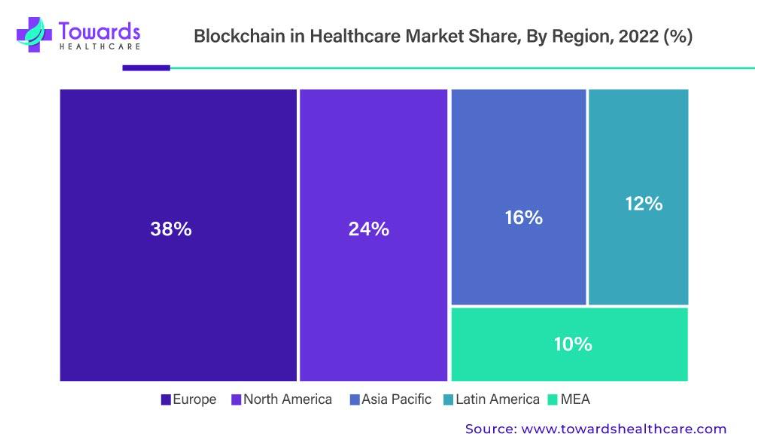The global blockchain in healthcare market witnessed substantial growth, reaching USD 0.76 billion in 2022. Projections suggest a staggering expansion to around USD 14.25 billion by 2032, with a robust CAGR of 34.02% from 2023 to 2032. This growth is propelled by factors such as the rising incidence of data breaches, increasing demand for data security solutions, and strategic initiatives by key players.

Key Highlights and Trends
Several trends and highlights characterize the evolving landscape of blockchain in healthcare:
- Biopharmaceutical and medical device firms dominate the end-use sector, leveraging blockchain for enhanced data security and supply chain management.
- Clinical data exchange and interoperability emerge as key sectors poised for significant growth, addressing vulnerabilities in data management and medication counterfeiting.
- The public sector leads in blockchain adoption, harnessing its potential for transparent and secure data sharing.
- Europe emerges as a frontrunner in blockchain adoption, driven by regulatory support, robust reimbursement schemes, and heightened awareness.
- Innovative applications such as Research Foundry facilitate the management of health data rights and consent, signaling promising prospects for blockchain in healthcare R&D.
A blockchain is delineated as an expanding compilation of cryptographically interlinked records acknowledged as blocks. Each block incorporates a cryptographic hash of its precursor, alongside a chronological indication and data on transactions. The chronological stamp validates the temporal alignment of transaction data upon block publication, thereby rendering it hashable. As each block encapsulates information regarding its antecedent, they coalesce into a chain, with every fresh block fortifying its antecedents. Consequently, blockchains manifest resistance to data tampering, as data within any block cannot retroactively undergo alteration sans impacting all subsequent blocks once inscribed.
Permissioned Blockchains and Permissionless Blockchains represent the two principal archetypes of blockchain in healthcare. Permissioned blockchains, also denoted as private blockchains, mandate authorization prior to utilization and solely afford access to sanctioned personnel. These impart heightened tailoring, access regulations, augmented scalability, reliability, and more streamlined functionality.
On-site and cloud-based deployments find utility in supply chain oversight, clinical data interchange and compatibility, claims adjudication and billing administration, alongside other applications. Entities such as healthcare providers, pharmaceutical corporations, healthcare insurers, and others serve as terminal consumers of blockchain within healthcare.
The burgeoning incidence of data breaches and information disclosures, coupled with the burgeoning exigency to redress these issues, propel market expansion. Strategic maneuvers by pivotal stakeholders, heightened demand for curbing pharmaceutical counterfeiting, and a requisite for efficacious health data management frameworks catalyze technology adoption.
Principal Highlights within the Blockchain Healthcare Sphere In 2022, Biopharmaceutical and Medical Device conglomerates commanded the most substantial market segment in the terminal usage sector. During the forecasted epoch, the clinical data exchange and interoperability sector of blockchain technology within the healthcare domain is anticipated to undergo notable compound annual growth. Clinical Data Interchange and Interoperability emerge as two of the most vulnerable processes concerning extensive data breaches and pharmaceutical falsification.
Regarding network categorization, the public sector spearheaded the market in 2022. Europe held sway over the most extensive market share by geographic zone in 2022, propelled by upsurges in data breaches, bolstering governmental regulations, commendable reimbursement schemas, heightened awareness, and an uptick in instructional initiatives. As per the OECD, a novel blockchain application christened Research Foundry has evolved to facilitate rights and consent management pertinent to health data sharing and access, software coding, metadata, and other healthcare R&D-related facets. Furthermore, increased investments in crafting effective healthcare record systems, cryptological wearable devices, and medical examination systems are envisaged to furnish lucrative prospects for this market in the foreseeable future.
Europe’s Market Dominance and North America’s Ascent
Amidst varied initiatives orchestrated by local administrations to curtail data breaches, Europe seized the dominant market share in the preceding year. For instance, the EU administration introduced the General Data Protection Regulation back in 2018 (GDPR). The enactment of GDPR, coupled with the extensive proliferation of blockchain technology, is anticipated to furnish heightened opportunities for enterprises within the region. Throughout the forecasted timeframe, North America is poised to secure the secondary-largest market share. The principal impetus behind regional expansion lies in the burgeoning demand for safeguarding medical records.















